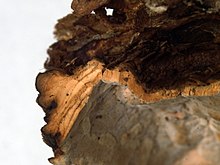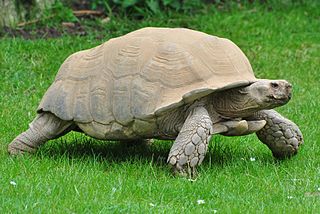
The African spurred tortoise, also called the sulcata tortoise, is an endangered species of tortoise inhabiting the southern edge of the Sahara Desert, the Sahel, in Africa. It is the largest mainland species of tortoise in Africa, and the third-largest in the world, after the Galapagos tortoise and Aldabra giant tortoise. It is the only living species in its genus, Centrochelys, with the five other species in the family already extinct.

Littorinimorpha is a large order of snails, gastropods, consisting primarily of sea snails, but also including some freshwater snails and land snails.

Callitris sulcata is a species of conifer in the cypress family, Cupressaceae. Its common name is Sapin de Comboui. It is endemic to New Caledonia, where it grows only in three forested river valleys. It is an endangered species with a global population of no more than 2500 individuals.

Anemonia sulcata, or Mediterranean snakelocks sea anemone, is a species of sea anemone in the family Actiniidae from the Mediterranean Sea. Whether A. sulcata should be recognized as a synonym of A. viridis remains a matter of dispute.
La Serre is a commune in the Aveyron department in southern France.
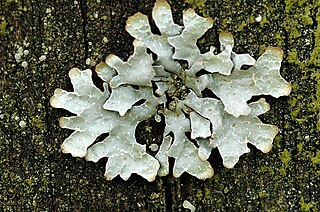
Parmelia sulcata is a foliose lichen in the family Parmeliaceae. It is very tolerant of pollution and has a cosmopolitan distribution, making it one of the most common lichens. It harbours a unicellular Trebouxia green algal symbiont.
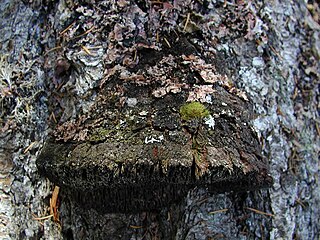
The Echinodontiaceae are a family of crust fungi in the order Russulales. Species of this family, divided amongst two genera—Echinodontium and Laurilia—have a widespread distribution, although they are especially predominant in north temperate zones. They are parasitic or saprobic on wood, and may cause white rot of angiosperms and gymnosperms.
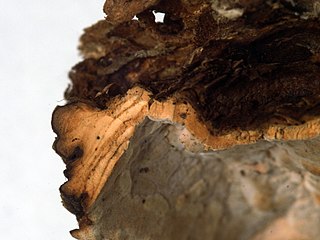
Laurilia is a monotypic genus of crust fungi in the family Echinodontiaceae. The genus was described in 1959 by Czech mycologist Zdeněk Pouzar, with Laurilia sulcata as the type and only species. Pouzar then transferred Laurilia taxodii from Stereum to Laurilia in 1968, but Liu et al. erected the new genus Laurillela for the latter species in 2017 on the basis of ribosomal DNA molecular phylogeny. Liu et al. also found the Echinodontiaceae as traditionally circumscribed to be paraphyletic and placed Laurilia and Lauriliella instead in the Bondarzewiaceae, though this placement is not yet reflected in taxonomic authorities such as the Index Fungorum.

Tudorella sulcata is a species of land snail which has an operculum, a terrestrial gastropod mollusk in the family Pomatiidae.

The 'Brahm Kai Meu' mango is a named mango cultivar of Thai origin. Although it is relatively new in Florida, it appears to be doing very well so far, in terms of growth and yield.

Subcancilla sulcata is a species of sea snail, a marine gastropod mollusk in the family Mitridae, the miters or miter snails.

Terebralia is a genus of sea snails, marine gastropod mollusks in the family Potamididae.

Sanbokan is a Japanese citrus fruit of the Wakayama prefecture similar to a mandarin orange, easily distinguished by its pronounced basal nipple.

Clavulinopsis sulcata is a clavarioid fungus in the family Clavariaceae and is the type species of the genus Clavulinopsis. It forms very long, slender, cylindrical pinkish or orange fruiting bodies that grow on the ground among plant litter.
Centrochelys atlantica is an extinct species of tortoise that lived in the Pleistocene. It was first recorded in the volcanic crater on Sal, Cape Verde. It was initially identified as similar to the extant Testudo calcarata. The species is no longer present anywhere in the Cape Verde islands. It has since been described as a new species, differentiated from C. sulcata by its smaller size and lesser robusticity. It does not seem there is any evidence this species came into contact with humans. Kehlmaier et al. (2021) identified the type material of this species as belonging to a specimen of the red-footed tortoise, making C. atlantica a junior synonym of the latter species and leaving the extinct tortoise known from fossils excavated on the Sal Island in the 1930s without a scientific name.

Persoonia sulcata is a plant in the family Proteaceae and is endemic to the south-west of Western Australia. It is a small, erect or low spreading shrub with narrow, linear leaves and cylindrical yellow flowers arranged singly or in groups of up to three in leaf axils. It grows in woodland or on rocky slopes and is found in several disjunct populations.
Grevillea sulcata is a species of flowering plant in the family Proteaceae and is endemic to a restricted area in the south of Western Australia. It is a robust, spreading shrub with linear leaves and erect clusters of up to 14 scarlet flowers with an orange pollen presenter.

Centrochelys is a genus of tortoise. It contains one extant species and several extinct species:

Kutorginates (Kutorginata) are an extinct class of early rhynchonelliform ("articulate") brachiopods. The class contains only a single order, Kutorginida (kutorginides). Kutorginides were among the earliest rhynchonelliforms, restricted to the lower-middle part of the Cambrian Period.
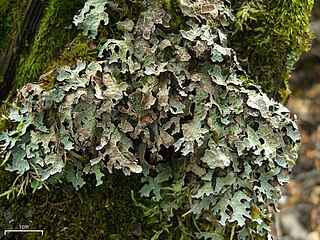
Parmelia barrenoae is a species of foliose lichen in the large family Parmeliaceae. It was formally described as a new species in 2005. Before this, it was lumped together as one of several lichens in the Parmelia sulcata group—a species complex of genetically distinct lookalikes. Parmelia barrenoae is widely distributed, occurring in Europe, western North America, Africa, and Asia.
